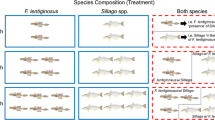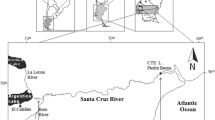Abstract
We compared dietary patterns within a temperate estuarine fish assemblage (Suisun Marsh, CA, U.S.A.) during a period of high mysid shrimp abundance and after a major decline in mysid abundance caused by the invasion of the overbite clam Potamocorbula amurensis. Prior to the invasion, high dietary overlap, high stomach fullness, and low niche breadth occurred among the fishes in spring when mysid populations were high. Dietary overlaps decreased and niche breadth increased for all species but the endemic splittail Pogonichthys macrolepidotus in fall when mysid populations were low. Eight native species exhibited lower overall collective overlaps and fuller stomachs than five alien species, suggesting more efficient resource partitioning. After mysid abundance declined, only alien striped bass Morone saxatilis preyed upon mysids in greater than trace amounts. An alien mysid became an important prey for small striped bass, but striped bass also switched to piscivory at a smaller size than when mysids were abundant. Eight of 13 species exhibited significant declines in abundance during the study period, which were concordant with the original importance of mysids in their diets. Our results suggest that altered lower food web dynamics in the San Francisco Estuary caused by the invasion of the overbite clam changed fish diets and have contributed to declines in fish abundance.
Similar content being viewed by others
References
Bennett, W.A. & P.B. Moyle. 1996. Where have all the fishes gone? Interactive factors producing fish declines in the Sacramento-San Joaquin Estuary. pp. 519–542 In: J.T. Hollibaugh (ed.) San Francisco Bay: The Ecosystem. Pacific Division, American Association for the Advancement of Science, San Francisco, CA.
Cohen, A.N. & J.T. Carlton. 1995. Non-indigenous aquatic species in a United States estuary: A case study of the biological invasions of the San Francisco Bay and Delta. Report prepared for the U.S. Fish and Wildlife Service. Washington, DC, 246 pp.
Feyrer, F. 1999. Feeding ecology of Suisun Marsh fishes. M.S. Thesis, California, State University, Sacramento, 60 pp.
Feyrer, F. & R. Baxter. 1998. Splittail fecundity and egg size. Calif. Fish Game 84: 119–126.
Gerking, S.D. 1994. Feeding Ecology of Fish. Academic Press, San Diego, CA, 416 pp.
Herbold, B. 1986. An alternative to the fullness index. pp. 315–320. In: C.A. Simenstad & G.M. Calliet (ed.) Contemporary Studies on Fish Feeding: The Proceedings of Gutshop '84. Dr W. Junk, Dordrecht, the Netherlands.
Herbold, B. 1987. Patterns of co-occurrence and resource use in a non-coevolved assemblage of fishes. Ph.D. Dissertation, University of California, Davis, 87 pp.
Herbold, B., A.D. Jassby & P.B. Moyle. 1992. Status and trends report on aquatic resources in the San Francisco Estuary. Report prepared for the U.S. Environmental Protection Agency, Oakland, CA, 257 pp.
Hostens, K. & J. Mees. 1999. The mysid-feeding guild of demersal fishes in the brackish zone of the Westerschelde estuary. J. Fish Biol. 55: 704–719.
Kimmerer, W.J. 2002. Effects of freshwater flow on abundance of estuarine organisms: Physical effects of trophic linkages? Mar. Ecol. Prog. Ser. 243: 39–55.
Kimmerer, W.J., E. Gartside & J.J. Orsi. 1994. Predation by an introduced clam as the likely cause of substantial declines in zooplankton of San Francisco Bay. Mar. Ecol. Prog. Ser. 113: 81–93.
Kimmerer, W.J., J.H. Cowan, L.W. Miller & K.A. Rose. 2000. Analysis of an estuarine striped bass (Morone saxatilis) population: influence of density-dependent mortality between metamorphosis and recruitment. Can. J. Fish. Aquat. Sci. 57: 478–486.
Kimmerer, W.J. & J.J. Orsi. 1996. Changes in the zooplankton of the San Francisco Bay Estuary since the introduction of the clam Potamocorbula amurensis. pp. 403–424. In: J.T. Hollibaugh (ed.) San Francisco Bay: The Ecosystem. Pacific Division, American Association for the Advancement of Science, San Francisco, CA.
Liao, H., C.L. Pierce & J.G. Larscheid. 2001. Empirical assessment of prey importance in the diets of predacious fish. Trans. Am. Fish. Soc. 130: 583–591.
Matern, S.A. 1999. The invasion of the shimofuri goby (Tridentiger bifasciatus) into California: establishment, potential for spread, and likely effects. Ph.D. Dissertation. University of California, Davis, 167 pp.
Matern, S.A., P.B. Moyle & L. Pierce. 2002. Native and alien fishes in a California estuarine marsh: twenty-one years of changing assemblages. Trans. Am. Fish. Soc. 131: 797–816.
Matthews, W.J., L.G. Hill, D.R. Edds, J.J. Hoover & T.G. Heger. 1988. Trophic ecology of striped bass, Morone saxatilis, in a freshwater reservoir (Lake Texoma, U.S.A.). J. Fish Biol. 33: 273–288.
Meng, L., P.B. Moyle & B. Herbold. 1994. Changes in abundance and distribution of native and introduced fishes of Suisun Marsh. Trans. Am. Fish. Soc. 123: 498–507.
Mittelbach, G.G. & L. Persson. 1998. The ontogeny of piscivory and its ecological consequences. Can. J. Fish. Aquat. Sci. 55: 1454–1465.
Moyle, P.B., R.A. Daniels, B. Herbold & D.M. Baltz. 1986. Patterns in the distribution and abundance of a noncoevolved assemblage of estuarine fishes in California. Fish. Bull. 84: 105–117.
Nichols, F.H., J.E. Cloern, S.N. Luoma & D.H. Peterson. 1986. The modification of an estuary. Science 231: 567–573.
Orsi, J.J. & W.L. Mecum 1996. Food limitation as the probable cause of a long-term decline in the abundance of Neomysis mercedis the opossum shrimp in the Sacramento-San Joaquin estuary. pp. 375–401. In: J.T. Hollibaugh (ed.) San Francisco Bay: The Ecosystem. Pacific Division, American Association for the Advancement of Science, San Francisco, CA.
Pianka, E.R. 1974. Niche overlap and diffuse competition. Proc. Natl. Acad. Sci. USA 71: 2141–2145.
Pope, K.L., M.L. Brown, W.G. Duffy & P.H. Michaletz. 2001. A caloric-based evaluation of diet indices for largemouth bass. Environ. Biol. Fish. 61 329–339.
Pothaven, S.A., T.F. Nalepa, P.J. Schneeberger & S.B. Brandt. 2001. Changes in diet and body condition of lake whitefish in southern Lake Michigan associated with changes in benthos. N. Am. J. Fish. Manag. 21: 876–883.
Pyke, G.H. 1984. Optimal foraging theory: a critical review. Annu. Rev. Ecol. Syst. 15: 523–575.
Thayer, S.A., R.C. Haas, R. Douglas Hunter & R.H. Kushler. 1997. Zebra mussel (Dreissena polymorpha) effects on sediment, other zoobenthos, and the diet and growth of adult yellow perch (Perca flavescens) in pond enclosures. Can. J. Fish. Aquat. Sci. 54: 1903–1915.
Thorman, S. 1982. Niche dynamics and resource partitioning in a fish guild inhabiting a shallow estuary on the Swedish west coast. Oikos 39: 32–39.
Turner, J.L. & D.W. Kelley (ed.) 1966. Ecological studies on the Sacramento-San Joaquin Delta. Calif. Fish Game Bull. 36: 1–168.
Van Snik Gray, E., J.M. Boltz, K.A. Kellogg & J.R. Stauffer, Jr. 1997. Food resource partitioning by nine sympatric darter species. Trans. Am. Fish. Soc. 126: 822–840.
Willette, T.M., R.T. Cooney & K. Hyer. 1999. Predator foraging mode shifts affecting mortality of juvenile fishes during the sub arctic spring bloom. Can. J. Fish. Aquat. Sci. 56: 364–376.
Winemiller, K.O. 1989. Ontogenetic diet shifts and resource partitioning among piscivorous fishes in the Venezuelan ilanos. Environ. Biol. Fish. 26: 177–199.
Winemiller, K.O. & E.R. Pianka. 1990. Organization in natural assemblages of desert lizards and tropical fishes. Ecol. Mon. 60: 27–55.
Xie, S., Y. Cui, T. Zhang & Z. Li. 2000. Seasonal patterns in feeding ecology of three small fishes in the Biandantang Lake, China. J. Fish Biol. 57: 867–880.
Zar, J.H. 1999. Biostatistical Analysis. 4th edition, Prentice Hall, Upper Saddle River, NJ, 663 pp.
Author information
Authors and Affiliations
Rights and permissions
About this article
Cite this article
Feyrer, F., Herbold, B., Matern, S.A. et al. Dietary shifts in a stressed fish assemblage: Consequences of a bivalve invasion in the San Francisco Estuary. Environmental Biology of Fishes 67, 277–288 (2003). https://doi.org/10.1023/A:1025839132274
Issue Date:
DOI: https://doi.org/10.1023/A:1025839132274




